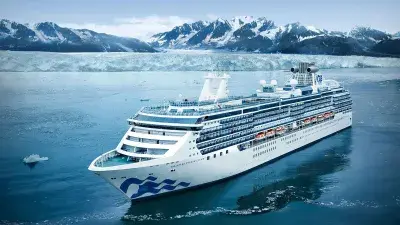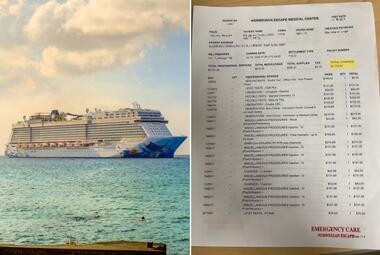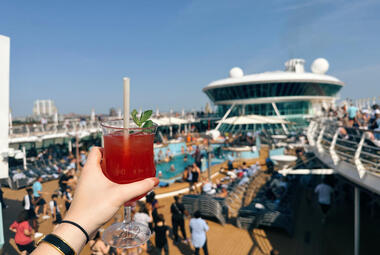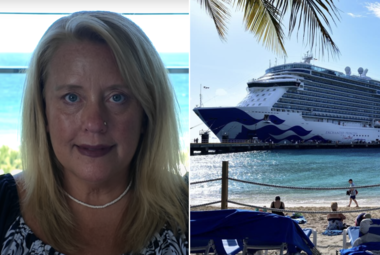Feeling unwell is the last thing you want on a fun cruise vacation. Unfortunately, it can happen.
One such ailment to be prepared for is seasickness. Whether you have suffered from it before or are new to cruising, it is a good idea to know what two do if you feel sick.
There are a number of things you can do, even pre-cruise, to help minimize the symptoms of seasickness. We have some some easy tips and tricks to minimize the impact of motion sickness that only require a quick trip to the drugstore and a little planning.
Here are some of the best known suggestions to help make you feel better on a cruise.
What is seasickness?

Seasickness is a type of motion sickness that some passengers experience on a boat or ship. To put it simply, it happens because your body is out of sync due to the movement of the water.
It all starts with the inner ears, which help keep you stay balanced. On a ship, the inner ears sense the movement of the ship before any other senses, which throws things off. This can cause the symptoms we commonly hear about such as dizziness, nausea, headaches, and fatigue.
Thankfully it usually passes, but no one wants to spend any time on their cruise not feeling well. Here are some of the top remedies and strategies to help mitigate the symptoms of seasickness.
Ship selection

Even before you step foot onto a ship, there are a few things you can do to help minimize seasickness, and one important factor to consider is the type of ship you choose.
The industry's newest and largest ships, such as Royal Caribbean's Oasis class ships, are particularly good at keeping the ship from rolling back and forth.
These modern cruise ships have stabilizers that act like wings under the water to help minimize movement. If you pick an older or much smaller ship, you may feel more motion, which is something to consider.
Cabin location

On the ship itself, cabins that are lower and midship tend to feel the least amount of movement, and perhaps the best if you are worried about feeling nauseous. While the back of the ship may offer some spectacular ocean views, you run the risk of feeling more swaying in these locations.
A balcony cabin can also be a good option, as many suggest fresh air and keeping an eye on the horizon to help with the symptoms. If you happen to feel unwell, spending some time outside on your own private balcony might be the ideal thing to make you feel better.
While recuperating, do resist the urge to read or spend a lot of time on your computer or phone, as this can further aggravate symptoms.
Itinerary

It can be tough to predict weather patterns, but some routes tend to have a greater chance of rough seas. Ocean crossings, such as transatlantic and transpacific, when cruise ships are repositioning ships between regions, can have more tumultuous water passages. You will spend more time out in the open ocean, and the seas can swell at times.
Popular cruise itineraries in the Caribbean often have great weather with calm seas; however, it is not a sure thing. An Alaskan cruise that voyages through the inside passage will have far calmer seas than those that sail in the Gulf of Alaska area.
Also, for those on adventurous routes, Antarctica can also have more turbulent weather. Anywhere where two bodies of water meet, such as some of the routes between Australia and New Zealand, are also more prone to choppy seas.
Storms/weather

Generally, cruise lines do a great job of steering their ships around storms. The chance of less favorable conditions can increase during hurricane season though. Even sailing far around storms, you can experience some rough waters.
Hurricane season runs from June to November and can impact the Caribbean, Central America, the Gulf of Mexico, and the east coast up to Canada, as well as Bermuda. It can also affect the west coast, including the Mexican Riviera and Hawaii.
In other regions, hurricanes have different names. In the Northwest Pacific Ocean, they are referred to as typhoons, and the storm season runs from April to December. In the South Pacific, they are called cyclones and spring up from November to April.
Food and drinks

What you eat and drink can help to lessen (or aggravate) some seasickness symptoms.
Ginger is well known for its ability to soothe an upset stomach. Raw ginger is probably not the best (or easiest) option on a cruise ship. Many people swear by ginger ale or ginger tea as a good alternative.
Other options include plain, starchy foods like crackers and toast. Do try to stay away from spicy, rich and heavier foods which can prolong an upset stomach.
Another tip is to stay hydrated, as a lack of fluid intake can worsen seasickness symptoms. No, this does not mean making good use of a drink package; water is a much better choice. Chamomile tea is another popular alternative to make you feel better.
Remedies

If, despite your best efforts, you still have some symptoms on the ship, there are some additional options to help.
It is a good idea to plan ahead if you think you will need any of these items. While cruise ships have some medications and other drugstore items, they may have them in limited supply and they can be more costly, so it is not a bad idea to pack them in your suitcase.
There are both natural and medical options that many people have found to help, including:
- Sea bands - Using some of the principles of acupuncture, sea bands are elastic bands that cruisers can wear on their wrists. They have a pressure stud inside that aligns with an acupressure point to alleviate symptoms. This drug-free method has shown some success in research, works quickly, and is low in cost.
- Medications such as Dramamine, Bonine or Gravol (they can have different names depending upon where you live) are over the counter medications to treat nausea and other motion related symptoms. These medications can make some people drowsy. Whatever you pick, it is best to consult your doctor/ pharmacist to be aware of any side effects.
- Patches - Some cruisers have found that a nausea patch works well. The patch goes behind your ear, where the medicine can easily be absorbed by the skin. To be effective, they need to be applied several hours before you expect to get sick and they last a couple days.









